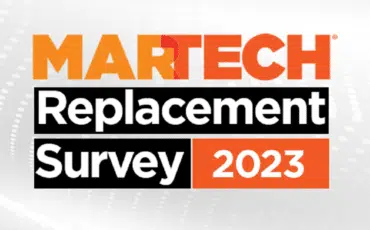Like surfers using the crest of change, we’re tasked with navigating the ebbs and flows of the ever-evolving advertising expertise panorama. This continuously altering ecosystem presents alternatives and challenges to our groups and organizations. Amid the potential chaos and complexity, agile advertising groups can discover distinctive benefits.
The martech panorama regularly unveils options that improve buyer engagement, personalize experiences and analyze behaviors. Nonetheless, to stay aggressive, retaining tempo with these improvements is essential. The exit of 689 firms from the martech scene previously yr underscores its aggressive nature and emphasizes the significance of fast adaptation to keep away from falling behind.
In my consulting work and writings, I repeatedly and fervently advocate for a strategic method towards innovation — important for successfully navigating the martech panorama.
That is the place a LinkedIn submit by Dr. Ken Knapton affords priceless insights. He introduces an intriguing idea — the “innovator’s dilemma of functioning expertise.” His proposition supplies a priceless framework to grasp the challenges companies face in managing their martech stacks amid fixed technological evolution.
Understanding the innovator’s dilemma and functioning expertise
The innovator’s dilemma, a time period coined by Clayton Christensen in his groundbreaking e-book, encapsulates the challenges established corporations — often called “incumbent” firms — face when confronted with disruptive applied sciences. These corporations typically take pleasure in vital market presence, a acknowledged model and economies of scale.
Nonetheless, their dimension and market place may cause them to focus excessively on refining current merchandise and applied sciences, neglecting to discover revolutionary but unproven options. This inherent bias towards their present profitable merchandise could restrict their adaptability and make them prone to transformative applied sciences launched by agile startups or revolutionary rivals.
This idea is additional expanded upon within the “functioning expertise” dilemma. This dilemma underscores the reluctance of incumbent corporations to put money into revolutionary applied sciences, promising enhanced reliability and effectivity over current methods.
This hesitancy extends past adopting new applied sciences. It additionally entails optimizing present instruments to maximise potential and fulfill their preliminary guarantees. Intriguingly, this reluctance persists even when the advantages of those rising or improved applied sciences are evident. It underscores the fragile steadiness these established corporations should strike between innovation and optimization.
An excellent instance of the paradox of functioning expertise is the query, “Why repair one thing that ain’t broke?” or “Why throw good cash at a system that doesn’t instantly generate revenue?” These questions could initially appear smart however typically overlook broader, long-term issues.
Drawing a comparability, advertising expertise methods want ongoing updates and upkeep, very like a tree requiring common care to bear fruit. Ignoring that is akin to disregarding the invisible “tech debt” that builds up over time attributable to outdated methods, postponed updates or quick-fix options.
The impression of expertise debt and addressing misconceptions
Expertise debt, typically undetected till a serious drawback surfaces, can rework minor glitches into vital roadblocks. Nonetheless, proactively managing this debt can enhance effectivity by as much as 50%, in line with Gartner. It’s important, although, to maintain this concentrate on tech debt from compromising the power to fulfill rising enterprise calls for.
For instance, a retail firm concentrating solely on updating its stock administration system may overlook the equally necessary must put money into an improved ecommerce platform.
This delicate steadiness underscores the significance of addressing tech debt and fostering innovation to remain aggressive in in the present day’s quickly evolving digital battleground.

Addressing frequent misconceptions about new applied sciences is paramount for organizations contemplating such investments. A few of these misconceptions embrace the consolation of the established order, resistance to alter and a perceived lack of time for studying new expertise. Debunking these myths can pave the best way for technological developments and increase competitiveness.
Dig deeper: Designing the advertising staff of the longer term
Methods for martech stack optimization
To effectively handle and optimize your martech stack on this dynamic setting, I draw on Dr. Knapton’s insights and suggest the next methods. These options goal to align the ever-evolving advertising applied sciences with enterprise objectives, driving advertising expertise optimization:
1. Predictive martech optimization
This method entails leveraging machine studying and synthetic intelligence to foretell future wants, challenges and alternatives inside your advertising expertise stack.
This might contain:
- Forecasting future buyer habits.
- Figuring out potential bottlenecks or inefficiencies in your present stack.
- Predicting the impression of latest applied sciences or updates.
This proactive method means that you can make strategic selections about your stack fairly than merely reacting to points as they come up.
2. Tech debt visualization
Expertise debt, as defined earlier, refers back to the future prices related to sustaining, updating or changing expertise. Visualization instruments may help quantify and illustrate this debt, making it simpler for stakeholders to grasp and handle.
This might contain:
- Creating visible dashboards that present the estimated future prices related to completely different components of your stack.
- Mapping out the projected lifespan of various applied sciences.
3. Integration of agile methodologies
Agile methodologies, initially developed for software program improvement, emphasize steady enchancment, adaptability and buyer satisfaction.
By adopting these methodologies within the context of martech, you’ll be able to constantly enhance your stack, adapting to altering wants and minimizing tech debt. This might contain:
- Recurrently reviewing and updating your stack.
- Prioritizing buyer wants.
- Encouraging a tradition of innovation and flexibility.
4. Martech well being rating
This can be a scoring system designed to evaluate the general well being and effectivity of a martech stack. This rating may contemplate components corresponding to:
- The age of various applied sciences in your stack.
- Their integration with different methods.
- Their alignment with enterprise objectives.
- Their contribution to tech debt.
This rating may help establish areas for enchancment and information strategic decision-making about your stack.
5. Martech resilience planning
This entails drafting plans to make sure your martech stack can operate successfully regardless of surprising occasions or disruptions. This may contain:
- Figuring out potential dangers (corresponding to technical failures or modifications in buyer habits).
- Planning for redundancies.
- Guaranteeing that your stack is versatile and adaptable sufficient to deal with modifications.
6. Tech debt ‘sustainability’ reporting
Recurrently reporting on tech debt helps increase stakeholders’ consciousness of the longer term prices of sustaining, updating or changing applied sciences in your stack.
This could drive dedication to sustaining an environment friendly and cost-effective martech stack and make sure that selections concerning the stack contemplate fast wants and future prices.
7. Composable structure
This method entails constructing your martech stack modularly in order that completely different elements could be added, eliminated or up to date independently.
This makes your stack extra versatile and adaptable and can even assist cut back tech debt by making updating or changing particular person elements simpler.
It encourages an revolutionary method to constructing and managing your martech stack, permitting for the straightforward integration of latest applied sciences as they turn out to be obtainable.
Embracing the innovator’s dilemma
On this age of digital disruption, sustaining an edge out there requires the braveness to navigate the innovator’s dilemma and sort out the paradox of functioning expertise head-on. An efficient martech technique and ecosystem will not be about making incremental modifications or suspending investments in new applied sciences. It’s about embracing the chaos of transformation and leveraging it to your benefit.
Deal with your martech stack as an evolving ecosystem that wants considerate administration fairly than frequent overhauls. Its nourishment comes from common updates, upkeep, and, often, even handed incorporation of transformative applied sciences.
Whereas fast returns on such strategic selections may have to be extra evident, these selections can result in cumulative advantages, driving aggressive benefit and progress over time.
The methods I’ve outlined right here present a roadmap for this journey. They assist to streamline operations, cut back tech debt and guarantee your martech stack stays strong and related amidst fast technological developments.
Bear in mind, the way forward for the martech panorama stays to be written. Its fixed evolution affords companies a possibility to form their narratives actively. Nonetheless, this entails stepping out of the consolation zone of current instruments, platforms and methods, adapting to modifications and making strategic selections — not merely including new applied sciences. It’s not about fixed acquisition however good, selective evolution.
Dig deeper: A sensible information to constructing a advertising expertise stack
Get MarTech! Every day. Free. In your inbox.
Opinions expressed on this article are these of the visitor creator and never essentially MarTech. Workers authors are listed right here.

